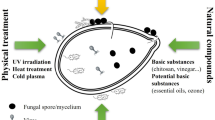Abstract
The survival of Rhizobium leguminosarum biovar phaseoli on seeds of bean was tested, using the cultivar Carioca. The seeds were treated seven days before inoculation with Benlate, Vitavax, Banrot, Difolatan or Ridomil fungicides. The rhizobial strains used were: CIAT 899, CPAC 1135 and CIAT 652. Strain CIAT 899 showed greater survival on the seed with fungicide than the other strains. Two hours after the contact with fungicides strains CIAT 652 and CPAC 1135 had significantly lower numbers of rhizobia than the treatment without fungicide. The Benlate and Banrot fungicides had the greatest effect on survival of rhizobial strains. There was a drastic mortality of the two strains, CIAT 652 and CPAC 1135, on seeds treated with Benlate and Ridomil. Under field conditions, granular inoculation produced fewer nodules, but a similar total nodule weight as seed inoculation. Serological tests (ELISA) showed that seed treatment with Benlate in connection with seed inoculation reduced drastically the occurrence of inoculated strains in nodules, while the same fungicide treatment and inoculation applied in the seed furrow did not affect the survival of the inoculated strain.
Similar content being viewed by others
References
Chamber M A and Montes F J (1982) Effects of some seed disinfectants and methods of rhizobial inoculation on soybean (Glycine max L. Merrill.). Plant and Soil 66, 353–360.
Clark M F and Adams A N 1977 Characteristics of the microplate method of enzyme-linked immunosorbent assay (ELISA) for the detection of plant viruses. J. Gen. Virol. 34, 475–483.
Curley T and Burton J C 1975 Compatibility of Rhizobium japonicum with chemical seed protectants. Agron. J. 67, 807–808.
De-Polli H, Souto S M and Franco A A 1986 Compatibilidade de agrotoxicos com Rhizobium spp. e a simbiose das leguminosas. EMBRAPA-UAPNPBS. Seropédica, RJ. 75p.
Diatloff A 1970 The effects of some pesticides on root nodule bacteria and subsequent nodulation. Aust. J. Exp. Agric. Anim. Husb. 10, 562–567.
Fisher D J and Haynes A L 1981 Effects of some fungicides used against cereal pathogens on the growth of Rhizobium trifolii and its capacity to fix nitrogen in white clover. Ann. Appl. Biol. 98, 101–107.
Graham P H, Ocampo G, Ruiz L D Duque A 1980 Survival of Rhizobium phaseoli in contact with chemical seed protectants. Agron. J. 72, 625–627.
Jones R and Giddens J 1984 Introduction of effective N2-fixing rhizobial strains into the soybean plant by use of fungicide resistance. Agron. J. 76, 599–603.
Kapusta G and Rouwnehorst D L 1973 Interaction of selection pesticides and Rhizobium japonicum in pure culture and under field conditions. Agron. J. 65, 112–115.
Kecskes M and Vicent J M 1973 Compatibility of fungicide treatment and Rhizobium inoculation of vetch seed. Acta Agron. Acad. Sci. Hung. 22, 1–2.
Kucey R M N and Bonetti R 1988 Effect of vesicular-arbuscular mycorrhizal fungi and captan on growth and N2 fixation by Rhizobium-inoculated field beans. Can. Soil Sci. 68, 143–149.
Lehri L K 1976 “In vitro” inhibitory effect of some fungicides on Rhizobium spp. and Azotobacter chroococcum. J. Ind. Soc. Soil Sci. 24, 214–261.
Lennox L B and Alexander M 1981 Fungicide enhancement of nitrogen fixation and colonization of Phaseolus vulgaris by Rhizobium phaseoli. Appl. Environ. Microbiol. 41, 404–411.
Lopes E S and Portugal E P 1986 Compatibilidade entre o trataento de sementes d amendoim comfungicidas, sobrevivencia de Rhizobium e nodulacao. Bragantia 45, 293–302.
Mallik M A B and Tesfai K 1985 Pesticidal effect on soybean-rhizobia symbiosis. Plant and Soil 85, 33–41.
Odeyemy O and Alexander M 1977a Resistance of Rhizobium strains to phygon, spergon and thiran. Appl. Environ. Microibiol. 33, 784–790.
Odeyemi O and Alexander M 1977b Use of fungicide-resistant rhizobia Rhizobium phaseoli, Rhizobium meliloti for legume inoculation. Soil Biol. Biochem. 9, 247–251.
Rai R 1985 Competitiveness and effectiveness of carbedazin-resistant mutant and indigenous Rhizobium strains of chickpea (Cicer arietnum L.) in calcarious soil. J. Agric. Sci. 104–341–344.
Rennie R J and Dubetz S 1984 Effect of fungicides and herbicides on nodulation and N2 fixation in soybean fields lacking indigenous Rhizobium japonicum. Agron. J. 76, 451–454.
Robson A D 1973 Mineral Nutrition. In Nitrogen Fixation Vol 3. Legumes. Ed. W J Broughton. pp. 36–55.
Saito S M T 1982 Avaliaco em campo da capacidade fixacao simbiotica de estirpes de Rhizobium phaseoli. Pesq. Agropec. brasileira 17, 999–1006.
Vincent J M 1970 A Manual for the practical Study of Root Nodule Bacteria. Blackwell Scientific, Oxford 164 p.
Author information
Authors and Affiliations
Rights and permissions
About this article
Cite this article
Ramos, M.L.G., Ribeiro, W.Q. Effect of fungicides on survival of Rhizobium on seeds and the nodulation of bean (Phaseolus vulgaris L.). Plant Soil 152, 145–150 (1993). https://doi.org/10.1007/BF00016344
Issue Date:
DOI: https://doi.org/10.1007/BF00016344




